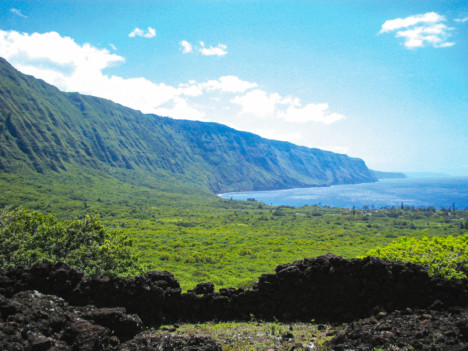Bill Plans for Future of Kalaupapa and Kalawao County
By Jack Kiyonaga, Editor
A new bill being heard in the Hawaii Senate looks at the impending future of Kalaupapa along with that of Kalawao County. With seven patient residents all between the ages of 83 and 100 remaining, four of whom call Kalaupapa their full-time home, state and federal agencies with responsibilities in Kalaupapa are preparing for the day when the settlement is without patients.
Currently, the Department of Health (DOH) is charged with most elements of patient care, with the National Park Service (NPS) running utilities, waste management and the maintenance of certain areas like the trail, cemeteries and other archeological sites. Along with DOH, state organizations like the Dept. of Land and Natural Resources and Dept. of Hawaiian Home Lands have land on the peninsula as well. According to the proposed bill, DOH will vacate Kalaupapa one year after the last patient passes away, ceding most of their responsibilities to NPS.
The bill, Senate Bill 1432 and companion House Bill 1113, explains that “after the passing of the last full or part time patient resident at Kalaupapa, the DOH will no longer provide patient care there but intends to complete environmental remediation work.”
The bill also proposes the establishment of the Kalaupapa State Historical Area, which would “commemorate and preserve the historical, cultural and environmental significance of the peninsula and its residents in Hawaii’s history.”
In addition to the changes in the agencies’ accountabilities, the bill also envisions dissolving Kalawao County and merging it with Maui County. Kalawao County is the smallest county by land area in the United States, comprising 12 square miles.
The dissolution of Kalawao County into Maui County raised some questions, concerns and creative thinking from Molokai residents at a Feb. 3 townhall meeting at the Mitchell Pauole Center when the subject of the upcoming bills was broached.
“Any suggestions about Molokai becoming part of Kalawao County?” asked Molokai resident Mahina Hou Ross at the townhall meeting. “I see it as a great opportunity for Molokai to take control of its governance and an opportunity to take control of our own island.”
Keani Rawlins-Fernandez, who hosted the townhall and is Molokai’s representative to the Maui County Council, said she would be supportive of an independent Molokai County, however the logistics of such a move would be complex.
Rawlins-Fernandez explained that Kalawao County lacks certain governance and regulatory structures needed to stand on its own once DOH leaves.
“There’s no planning commission…there’s no process for shoreline management, or SMA applications,” explained Rawlins-Fernandez.
Currently, NPS has a collaborative agreement with certain Maui County facilities like fire and police for use in Kalaupapa.
An independent Molokai County governance structure would only have to be a fraction the size of Maui County’s, Rawlins-Fernandez explained, “however there are some logistics that are really important such as fire and county employee pensions.”
At the Senate hearing for the bill by the Health and Human Services and the Energy and Intergovernmental Affairs committees on Feb. 6, several organizations and individuals offered testimony. The DOH and Dept. of Land and Natural Resources testified in support of the bill, with Ka ‘Ohana O Kalaupapa – an organization of patient residents, family members and supporters – proposing amendments to include further consultation with topside-Molokai stakeholders. Rawlins-Fernandez likewise testified, asking that the bill be differed to allow for further community and county discussions.
At the Feb. 6 hearing, the senate bill was passed with Ka ‘Ohana O Kalaupapa’s amendments. It will next be voted on by the Senate’s Ways and Means and Judiciary committees, although that hearing has yet to be scheduled.












Don't have a Molokai Dispatch ID?
Sign up is easy. Sign up now
You must login to post a comment.
Lost Password